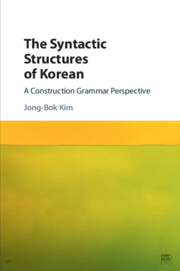Book contents
- Frontmatter
- Contents
- Acknowledgments
- Abbreviations
- 1 Theoretical foundations
- 2 Noun phrases
- 3 Case system
- 4 Auxiliary and complex predicate constructions
- 5 Gerund phrases and mixed categories
- 6 Verbal nouns and light verb constructions
- 7 Serial verb constructions
- 8 Negation and related phenomena
- 9 Coordination
- 10 Passive constructions
- 11 Wh-questions
- 12 Topic and focus constructions
- 13 Relative clause constructions
- 14 Honorification
- References
- Index
9 - Coordination
Published online by Cambridge University Press: 05 July 2016
- Frontmatter
- Contents
- Acknowledgments
- Abbreviations
- 1 Theoretical foundations
- 2 Noun phrases
- 3 Case system
- 4 Auxiliary and complex predicate constructions
- 5 Gerund phrases and mixed categories
- 6 Verbal nouns and light verb constructions
- 7 Serial verb constructions
- 8 Negation and related phenomena
- 9 Coordination
- 10 Passive constructions
- 11 Wh-questions
- 12 Topic and focus constructions
- 13 Relative clause constructions
- 14 Honorification
- References
- Index
Summary
Every language employs its own coordination strategies, according to the type of coordinating marking, the pattern of marking, the position of the marker, and the phrase types coordinated. Korean is also intriguing in the sense that it displays almost all the possibilities of these dimensions. This chapter shows how a construction-based HPSG can provide a robust analysis for nominal and verbal coordination in Korean.
Two main types of nominal and verbal coordination
Korean employs two kinds of coordination marking: morphological and lexical marking. In the morphological marking system, the language distinguishes nominal and verbal coordination. As seen in the corpus example (1a), nominal coordination uses suffixal markers (usually called particles in the traditional literature) like -(k)wa, -hako, -(i)lang ‘and’ for conjunctive and -(i)na ‘or’ for disjunctive coordination. Meanwhile, as in (1b), verbal coordination uses the suffixal marker -ko ‘and’ for conjunctive and -kena ‘or’ for disjunctive coordination:
(1) a. [khemphyuthe-wa/hako/lang intheneys-ul] payw-ess-ta
computer-and internet-ACC learn-PST-DECL
‘(He) learned computer and internet.’
b. pelley-ey [mwulli-ko/kena sso-i-yess-ta]
insect-DAT bite-and/or sting-PASS-PST-DECL
‘(He) was bitten and/or stung by an insect.’
In addition to these morphological markers, the language has words like kuliko ‘and’, ttonun ‘or’ as lexical coordinators. Unlike the morphological coordinators, these coordinators can be used for both nominal and verbal coordination:
(2) a. hay-wa tal kuliko sem-i hamkkey ha-nun kos
sun-and moon and island-NOM together do-MOD place
‘the place where sun, moon, and island exist together’
b. mak-kena ttonun phiha-l swu iss-ta
block-or or avoid-MOD possibility exist-DECL
‘(You) can block or avoid it.’
- Type
- Chapter
- Information
- The Syntactic Structures of KoreanA Construction Grammar Perspective, pp. 204 - 225Publisher: Cambridge University PressPrint publication year: 2016



